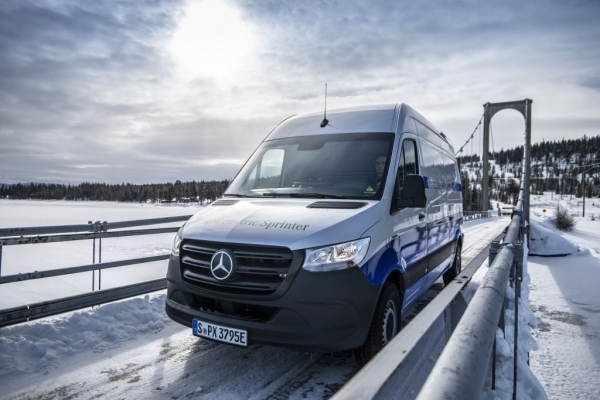25.3.2019 Arjeplog, Sweden. Electric Transporter customers with the same requirements as their counterparts with combustion engine. One of the most important factors here: Full reliability, even in adverse conditions. Exactly, the state at the time of the winter testing of the Mercedes-Benz eSprinter in focus.
For several weeks, the development team underwent the all-electric truck in Arjeplog, Sweden, a real test of endurance. At temperatures of up to minus 30 degrees Celsius, icy road and deep snow of the eSprinter proved its operational capability under extreme conditions. Thus, the vehicle has taken one of its last milestones on the way to market introduction in the second half of the year 2019.
In the demanding proving grounds near the Arctic circle went through the vehicles in a variety of complex Tests. It tested, among other things, when driving on frozen lakes, the effects of extreme cold on Handling, ergonomics, and comfort, using special measurement technology. In cold cells, the start-up behavior, as well as the cold hedge of the drive components, Software, and interfaces is verified.
In order for electric vans in daily use, for example, in the CEP sector (courier, Express, package), reliable functioning, it is crucial how the vehicles react to different weather conditions. With approximately 1501 kilometres in the configuration of an installed battery capacity of 55 kWh of eSprinter is optimally adapted to the urban transport delivery designed. The Tests in Sweden have shown that Even in the present unfavorable external conditions, a range of about 1001 km of the customers.
Electro-mobility at Mercedes-Benz level: High quality and safety standards for the driver’s workplace
Who is a day with a van on the road, makes high demands on its driver’s workplace. Therefore, quality and safety play equally in the case of electric-powered Vans have a special role. Even at temperatures well beyond the freezing point, the discs need to be de-iced as quickly as possible and the driver’s cabin can be reliably heated. For this purpose, the test vehicles and their batteries were placed in special refrigeration of the cells are initially at low temperature, and then the start behavior, and to test thermal management, the so-called cold start. Another important Element of the Tests: The charging behavior. The eSprinter has a built-in fast charging feature, which he can recharge within 30 minutes, around 80 percent of energy – a big Plus to flexibility in everyday Transportation, regardless of the temperature to function reliably.
In daily use, essential for a reliable Handling in ice and snow, and the winter resistance of all components. Exactly this is a must have to ensure about 30 engineers, Electronics experts and mechanics are Mercedes-Benz Vans through their numerous Tests in Arjeplog, Sweden. The conclusion of the tester: The eSprinter is fit for the customers use in the Arctic environment.
“We have demanded of our eSprinter at the final winter testing everything,” says Benjamin Kaehler, head of the eDrive@VANs at Daimler AG. “Through our extensive testing, we were able to get our second fully-electric vans to the eVito once the last percentage points on the path to full market maturity. In particular, for electric Vans the essential discipline of thermal management, we were able to gain important insights, in order to make the eSprinter even safer and more comfortable. We are very proud of the result and look forward to our customers very soon, an extremely reliable under all conditions everyday product.“
eSprinter on the same level as the segment founder
In Arjeplog by the eSprinter ran his last winter tests, before he follows in the second of the year 2019, the eVito on the market helped. The new eSprinter will initially be offered as a panel van with high roof and a GVW of 3500 kg. The maximum load volume is at a comparable Sprinter with an internal combustion engine at 10.5 m3.
With an installed battery capacity of 55 kWh, the estimated range is approximately 1501 kilometres, with a maximum payload of 900 kilograms. With the second battery option, customers can set different priorities for the use of this parameter. A capacity of 41 kWh allows for up to approximately 140 kg higher payload of a total of about 1040 kilograms at a range of approximately 1151 kilometres. For even more flexibility, the built-in fast charging function, within 30 minutes, around 80 percent of the energy can be loaded. The electric drive in the eSprinter makes similar to Diesel-introduction units of 85 kW with a torque of 300 Newton metres. As the eVito the maximum speed is suitable for the application purpose to configure a Maximum speed of 80 km/h, 100 km/h or 120 km/h.
1 information on the electric range are provisional. To EC type-approval and certificate of conformity with the official values are not yet available. Deviations between the data and the official values are possible.


Winter testing Mercedes-Benz eSprinter in Sweden